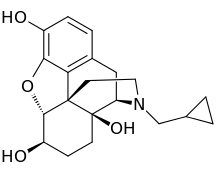6β-Naltrexol
 | |
| Clinical data | |
|---|---|
| ATC code |
|
| Pharmacokinetic data | |
| Biological half-life | 12–18 hours[1] |
| Identifiers | |
| |
| CAS Number | |
| PubChem CID | |
| ChemSpider | |
| UNII | |
| ECHA InfoCard | 100.230.713 |
| Chemical and physical data | |
| Formula | C20H25NO4 |
| Molar mass | 343.417 g/mol |
| 3D model (JSmol) | |
| |
| |
6β-Naltrexol, or 6α-hydroxynaltrexone, is a major active metabolite of naltrexone formed by hepatic dihydrodiol dehydrogenase which acts as a potent, peripherally selective opioid neutral antagonist.[2][3] Relative to naltrexone, 6β-naltrexol has about half the affinity for the μ-opioid receptor,[1] but is present at approximately 10–30-fold higher concentrations at steady state due to extensive first-pass metabolism of the parent drug.[4] 6β-Naltrexol was itself investigated as an opioid antagonist, specifically for the treatment of opioid-induced constipation, and was found to be effective and well-tolerated, but was not further pursued.[2]
See also
References
- 1 2 Reginald Dean; Edward J. Bilsky; S. Stevens Negus (12 March 2009). Opiate Receptors and Antagonists: From Bench to Clinic. Springer Science & Business Media. pp. 269–. ISBN 978-1-59745-197-0.
- 1 2 Howard S. Smith (21 February 2013). Opioid Therapy in the 21st Century. Oxford University Press. pp. 69–. ISBN 978-0-19-984497-5.
- ↑ Charles J. Cote; Jerrold Lerman; Brian J. Anderson (2013). A Practice of Anesthesia for Infants and Children: Expert Consult - Online and Print. Elsevier Health Sciences. pp. 148–. ISBN 1-4377-2792-1.
- ↑ Mellar P. Davis; Paul A. Glare; Janet Hardy (28 May 2009). Opioids in Cancer Pain. Oxford University Press. pp. 41–. ISBN 978-0-19-923664-0.
This article is issued from
Wikipedia.
The text is licensed under Creative Commons - Attribution - Sharealike.
Additional terms may apply for the media files.